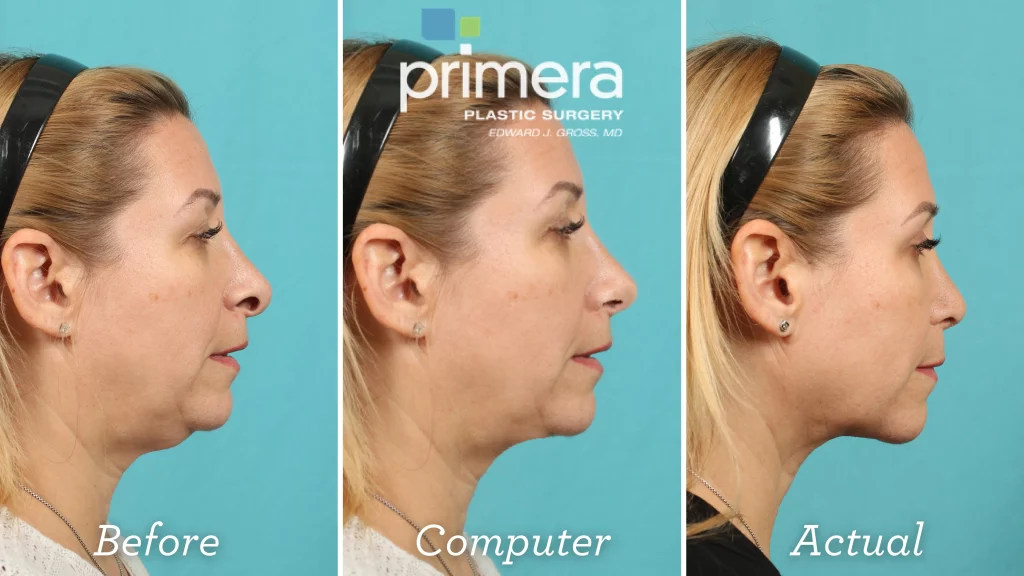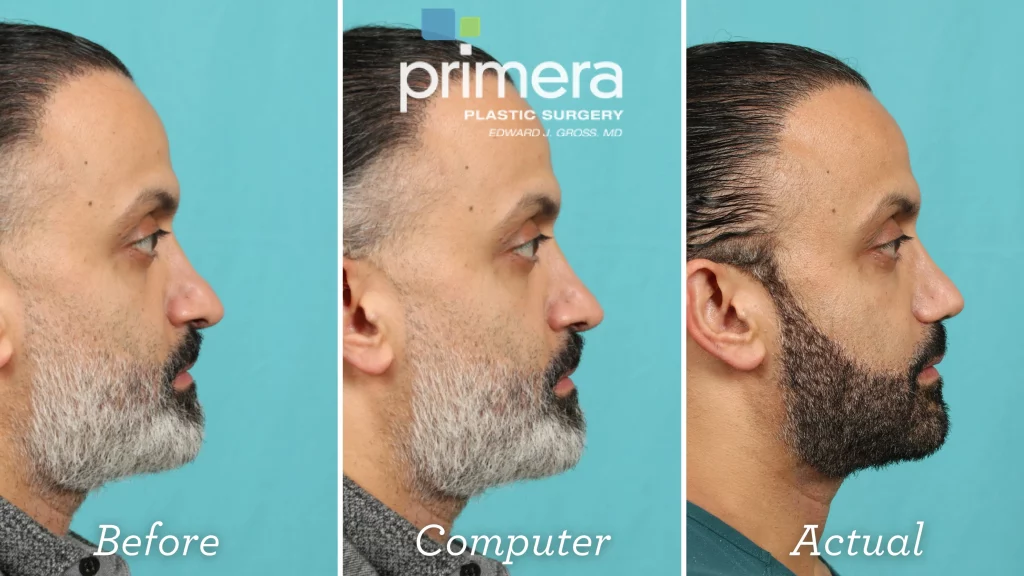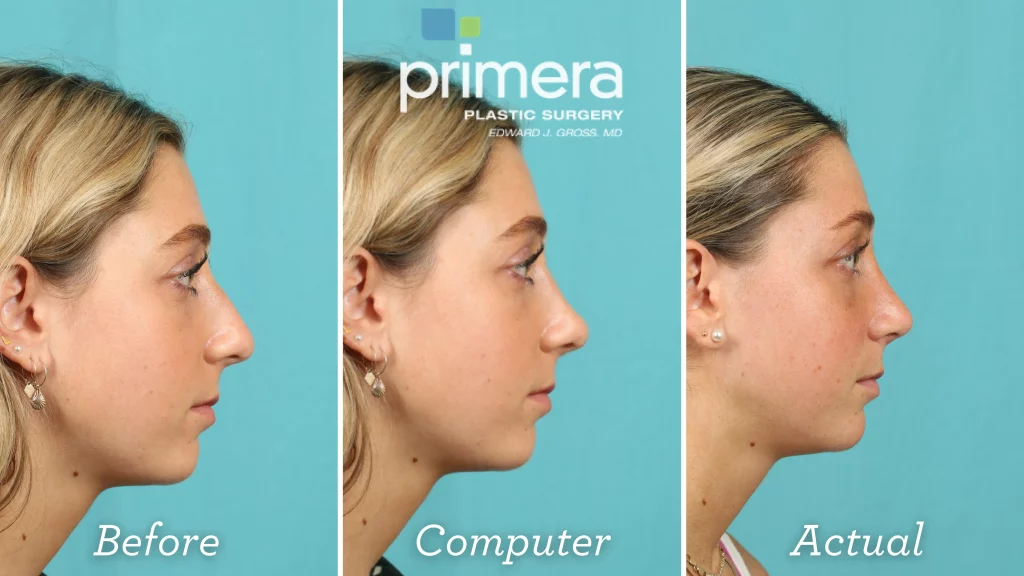Technology has heavily impacted the plastic surgery field. One of the technologies making a difference in plastic surgery outcomes today is digital imaging, which allows doctors and patients to visualize surgical outcomes before the procedure takes place.
This innovative technology not only allows doctors to visualize the outcome of the procedure but gives patients a beforehand look at what they may expect from surgery.
Edward J. Gross, M.D., double board certified facial plastic and reconstructive surgeon and founder of Primera Plastic Surgery, says, “We use a computer imaging system to help you visualize your rhinoplasty results before you undergo surgery.”
Digital imaging technology allows patients and surgeons like Dr. Gross to better communicate goals and set patient expectations for each procedure. Knowing the outcome will oftentimes inform whether or not a patient decides to undergo the procedure and can help doctors make adjustments to provide patients with their desired outcome.
In this article, we’ll explore the benefits of digital imaging software for plastic and reconstructive surgical procedures.
What Is Digital Imaging for Plastic Surgery?
Digital imaging for plastic surgery involves the use of specialized software and equipment to create realistic simulations of surgical outcomes. These visual simulations allow patients to see how their appearance may be improved by plastic surgery and enables surgeons to plan and execute these surgical procedures more effectively.
Dr. Gross says, “This technology helps me assess the anatomy and symmetry of your facial features.” The process works by taking a series of digital photographs of the patient’s face, which are then uploaded into the digital imaging software. The computer uses those pictures to create a 3D simulation of your current appearance. The surgeon can use the software to change various aspects of the simulation to create a representation of how your face will look after the surgery.
Changing the size, shape, and positioning of your features, whether it’s the chin, nose, or ears, can help you visualize how you will look after surgery. The software can do the same for changes in skin texture, laxity, wrinkle removal, which is a common benefit of procedures such as a facelift.
Once the simulation is complete, you can view your “new look” on the computer screen and provide feedback to the doctor. The surgeon then uses the feedback to make further adjustments to the simulation until you both agree on the desired appearance that’s achievable.

How Is Digital Imaging Used for Plastic Surgery Patients?
Digital imaging is used for a wide range of plastic surgery procedures, from facelifts to rhinoplasty.
Dr. Gross says he uses digital imaging for the following procedures:
- Rhinoplasty
- Chin Implant
- Profile Surgery
- Facelift
- Mini Lift Surgery
- Eyelid Lifts (Blepharoplasty)
- Neck Lifts
- Buccal or Cheek Fat Removal
- Ear Pinning (Otoplasty)
Digital imaging has significantly improved communication between doctors and patients, allowing for a more precise and accurate representation of the “before and after” of any plastic surgery. Dr. Gross can manipulate the pixels of the face to show how the surgery can change your features. He says, “Once we’re satisfied with your projected results, my team emails the photos to you as a reference.”
Digital imaging puts some of the control in the hands of the patient, for better surgical outcomes and increased satisfaction with these important skin and facial enhancing procedures.

What Are the Pros of Digital Imaging for Plastic Surgery?
The benefits of digital imaging for plastic surgery far outweigh any potential drawbacks of using these tools. The key benefits include:
- Improved communication
- Enhanced patient satisfaction
- Better surgical outcome expectations
- Cost-effective approach
- Increased patient/doctor confidence
With digital imaging in place, improved doctor-patient communication means that you’ll have a higher likelihood of achieving your desired outcome from surgery. In the past, patients had to rely on verbal descriptions or even hand-drawn sketches to convey their desired outcome to a surgeon. This process often led to miscommunication, misunderstandings, and poor surgical outcomes.
Dr. Gross says, “The imaging provides a tailor-made guide that I follow to ensure that you achieve the best possible results.” Digital imaging offers a more precise and accurate way for patients to communicate with doctors about their goals for the surgery.
Better communication about how you’ll look after the surgery improves satisfaction with these life-changing procedures. Having a visual representation of the procedure can give you a better sense of what to expect after the procedure is complete.
Patients also feel more a part of the surgical process when using digital imaging technology. As part of the pre-surgical consultation with Dr. Gross, you can provide input into the outcome of your procedure. By doing this, you’ll improve the chance that you will have the surgical results that you desire and won’t be surprised once the bandages are removed. This advanced planning process reduces complication risks during surgeries and improves the accuracy of the result.
During your procedure, Dr. Gross will refer to the simulation to determine the best course of action, guiding surgery based on your desired results. For many patients, digital imaging prevents the need for revision surgery, providing the optimal results during the first procedure.

Are There Any Drawbacks to Using Digital Imaging?
Digital imaging as a tool for surgery is still evolving and has been proven as an effective tool to help patients and doctors achieve the patient’s best results from a procedure.
Although there are few downsides to digital imaging, it can take time to develop the simulated results sometimes, depending on how involved the procedure is and the allotted consultation time with Dr. Gross. Likewise, the technology does have pixelation limitations and cannot predicate the outcome of the surgery with an exact degree of accuracy. However, Dr. Gross will account for these minor discrepancies and compensate for them during the procedure.
Overall, the pros of digital imaging still far outweigh the drawbacks.
This technology bridges the gaps between how patients imagine they will look versus what Dr. Gross can realistically achieve. Digital imaging has revolutionized the field of plastic surgery so that Dr. Gross and his team can improve your experience with our practice.
Still, have questions? Contact our team today to find out how we can help.

Leave a Reply